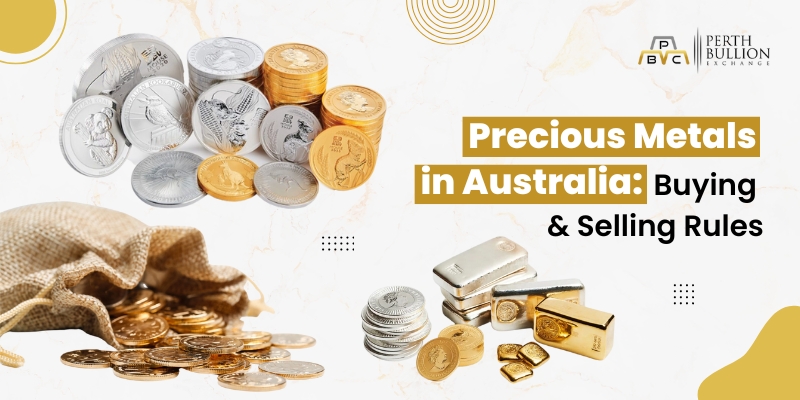Checking Gold Purity in Australia: A Step-by-Step Guide for Safe Purchases
Gold is a symbol of wealth, but it is also a secure type of investment. From the gold rush days of the 1850s to the present, bullion trading has remained one of the most reliable long-term financial stability assets. Nonetheless, like any precious commodity, fake or poor-quality gold is available in the market.
To assist in safeguarding both investors and enthusiasts, this guide walks you through the real-life steps of determining gold purity in Australia. This information enables buyers and investors to make informed decisions and avoid purchasing counterfeit or substandard gold.
Understanding Gold Purity in Australia
Gold purity is used to define the percentage of gold in an object, typically in relation to other metals. It is often expressed in parts per thousand (fineness) or in carats (k).
- 24K gold (999 fine): The most common gold that is used in bullion, which is almost pure gold.
- 22K (916 fine) gold, which is 91.6% pure, is commonly found in high-quality jewellery.
- 18K gold (750 fine): 75% pure, durable and beautiful.
The National Measurement Act is strict in Australia. Gold sold as such should be hallmarked with the correct purity levels, which will give the purchaser confidence in what they are buying.
Step 1: Look for Hallmarks and Stamps
The first indication of authenticity is the presence of hallmarks. Markings commonly used in Australia are:
- 999 or 9999 – 99.9 or greater purity
- 916 – representing 22K gold
- 750 – representing 18K gold
These are stamps that are typically located on the side of coins, the back of jewellery fasteners, or the front of bullion bars. There will also be unique mint marks on genuine products of the Perth Mint or other reputable refineries, which will serve as a mark of authenticity.
Step 2: Use a Magnet Test
Gold is a non-magnetic metal; thus, a magnet test is a fast method of identifying fakes. Place a magnet close to your piece of gold, and if it sticks, the piece is likely an alloy or base metal.
With that said, this test has its limitations. Other counterfeiters use non-magnetic metals that can withstand this test. Thus, the magnet test can be applied as a primary screening only.
Step 3: Check with a Nitric Acid Test
A conventional method of purity checking is the acid test. A small piece of gold is scratched on the surface, and a drop of nitric acid is applied. The pure gold will not change, but other metals will react to the bubbles or discolouration.
Acids are dangerous to work with. A professional assayer should carry out this test, unless you have experience doing it yourself. It is also dependable, yet a little destructive, as it can leave a small mark on the piece.
Step 4: Conduct a Density Test
Gold weighs more than most metals, with a specific gravity of 19.32 g/cm³. This test involves:
- Measuring the weight of the item
- Putting it in water and displacing it
- Calculate the density by dividing the weight by the volume.
When the outcome gives a near miss of the actual density of gold, then the object is probably real. This test is usually defeated by counterfeit gold-plated products, which are less dense.
Step 5: Use Electronic Gold Testers
The technology today has simplified purity checks. Electronic gold testers are used to check the conductivity to ascertain the carat value. They are fast, precise, and non-destructive, and they are popular among routine purchasers in Australia.
Although electronic tests can be expensive, they provide reliable results for frequent investors in bullion and jewellery.
Step 6: Visit a Reputable Assayer
A professional assessment is the safest option when one is in doubt. In Australia, certified assayers employ sophisticated techniques, including X-ray fluorescence (XRF), in their analyses of gold composition, thereby avoiding any destruction of the work.
This is particularly critical when making significant purchases, such as bullion bars or investment-grade coins. The fee for professional testing is relatively affordable and reasonable, whilst guaranteeing authenticity.
Safe Buying Practices in Australia
In addition to testing, safe purchasing practices can go a long way in securing your investment. Consider these tips:
- It is recommended to purchase gold from licensed dealers or reputable mints, as this ensures compliance with Australian standards.
- Check certifications and read reviews posted by customers before making a decision.
- It is advisable to avoid personal sellers or web offers that appear to be overly aggressive.
- Ensure that a certificate of authenticity accompanies each purchase.
Legal Considerations
Consumer protection laws regarding precious metals in Australia are good. The sellers should accurately describe the products and display the correct purity marks. Buyers are entitled to:
- Purchases: Receipts and documentation of everything.
- Authenticity certificates of the bullions and the high-value pieces.
This is the right to report suspected counterfeit gold to the Australian Competition and Consumer Commission (ACCC). If you have any doubts about dealing with counterfeit gold, contact an expert assayer immediately and refer the matter to the consumer departments.
Conclusion
Gold remains a popular investment in Australia, valued for its role in long-term stability and portfolio diversification. Authenticating purity secures your fortune, be it in the case of buying a gold bar, a coin or a jewel. Simple DIY tests, such as using magnets and density determination, can be used to determine authenticity, which can also be achieved with a professional method, such as XRF analysis.
Use these methods in conjunction with safe purchasing practices and legal knowledge, and you will have significantly less to worry about. For help with buying real gold in Australia, contact Perth Bullion Exchange today!




Comments
Post a Comment